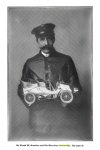All,
I am trying to help my brother-in-law obtain some information about a model locomotive he inherited from a relative in Connecticut. I was hoping that someone in this forum could provide this information or point us to the right set of experts.
The locomotive in question (photos attached) is a 3.5" gauge, 1:16 scale (3/4" to the foot) model of the NYC&HRR Model 999, which set some speed records around the late 1890s. There are no maker's marks, serial numbers etc anywhere on the locomotive, so my brother-in-law believes it was made by hand by a relative of his, probably around 1910. Some parts are made out of sheet metal. It is a full working model. Pete pressurized the main steam chest with air and it sent pressure to the drive steam boxes on each side. It has sliding valves that transfer the pressure to the front and then to the rear of the drive piston which turns the wheels. There is a functioning rack underneath the engine that times the valves to open and close properly. He thinks he just has to make some adjustments and then it will drive itself. It has been intricately made. We are interested in knowing where and when the locomotive was made and any other information about it.
Thanks,
Mark
I am trying to help my brother-in-law obtain some information about a model locomotive he inherited from a relative in Connecticut. I was hoping that someone in this forum could provide this information or point us to the right set of experts.
The locomotive in question (photos attached) is a 3.5" gauge, 1:16 scale (3/4" to the foot) model of the NYC&HRR Model 999, which set some speed records around the late 1890s. There are no maker's marks, serial numbers etc anywhere on the locomotive, so my brother-in-law believes it was made by hand by a relative of his, probably around 1910. Some parts are made out of sheet metal. It is a full working model. Pete pressurized the main steam chest with air and it sent pressure to the drive steam boxes on each side. It has sliding valves that transfer the pressure to the front and then to the rear of the drive piston which turns the wheels. There is a functioning rack underneath the engine that times the valves to open and close properly. He thinks he just has to make some adjustments and then it will drive itself. It has been intricately made. We are interested in knowing where and when the locomotive was made and any other information about it.
Thanks,
Mark




